Sarah Sundin's Blog, page 175
January 31, 2020
Today in World War II History—January 31, 1939 & 1945

Troops of US 82nd Airborne Division marching behind M4 Sherman tank in a snowstorm toward German occupied town of Herresbach, Belgium, 28 Jan 1945 (US Army photo)
80 Years Ago—January 31, 1940: US sends out the first monthly Social Security check, for $22.54 to a retired Vermont legal secretary Ida May Fuller.
75 Years Ago—Jan. 31, 1945: Germans in France and Belgium are pushed back to positions held before the Battle of the Bulge.
Pvt. Eddie Slovik is executed in France, the first US soldier executed for desertion since the Civil War.
US 11th Airborne Division makes an amphibious landing at Nasugbu Bay south of Manila on Luzon.
January 6, 2020
Pre-Order The Land Beneath Us – And Receive Goodies!
 The Land Beneath Us is coming February 4, 2020! My publisher, Revell Books, and I have put together a fun package of goodies for everyone who pre-orders a copy (or has already done so) and enters by February 3, 2020!
The Land Beneath Us is coming February 4, 2020! My publisher, Revell Books, and I have put together a fun package of goodies for everyone who pre-orders a copy (or has already done so) and enters by February 3, 2020!
You can pre-order at your local bookstore or online (find links here). Any version counts, including e-books and audio books!
As my thanks to you for pre-ordering The Land Beneath Us (Book 3 in the Sunrise at Normandy Series), you will receive:
The Land Beneath Us zipper pouch! (ONLY for the first 100 people who enter! So don’t wait!) – see photo above – it’s super-cute!
A downloadable map showing the sites in the Sunrise at Normandy series.
A downloadable poster of a poem written by Leah Jones, the book’s heroine!
Downloadable bookmarks with bookish quotes from The Land Beneath Us !
A signed customized bookplate
The Land Beneath Us Bookmarks
Postcards
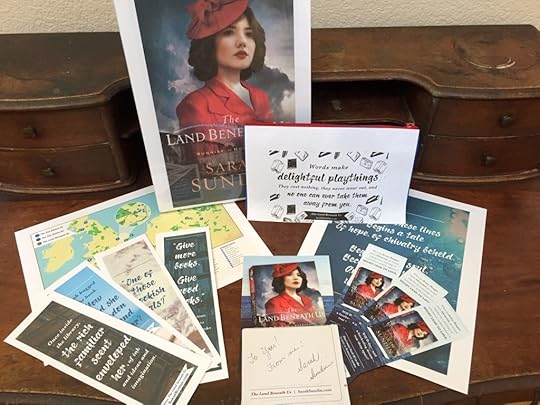
Pre-order goodies for The Land Beneath Us! Note – the pouch is just a mock-up since I don’t have mine yet. It’ll look like the pouch in the top image.
To receive your goodies, pre-order your copy of The Land Beneath Us—or find your confirmation number if you’ve already done so! Then contact me at sarahsundin10@sbcglobal.net with the following information (you can copy & paste this list into your email):
Name:
Mailing address:
Where did you pre-order The Land Beneath Us?
Order confirmation number:
Would you like bookmarks? How many?
Would you like postcards? How many?
Would you like signed bookplates? To whom would you like them autographed?
Note: zipper pouch available for US mailing addresses only – and only for the first 100 people! I reserve the right to limit quantities of bookmarks & postcards mailed to addresses outside the US.
Offer ends February 3, 2020, so don’t wait! By pre-ordering, you’ll receive the book first—and you create interest in bookstores that helps the book succeed.
December 30, 2019
Today in World War II History—December 30, 1939 & 1944
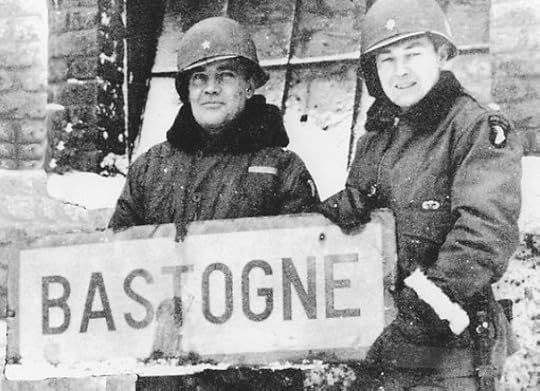
Brig. Gen. Anthony McAuliffe and Lt. Col. Harry Kinnard II at Bastogne, Belgium, late Dec 1944 (US War Dept. photo)
75 Years Ago—December 30, 1939: Movie premiere of Of Mice and Men, starring Burgess Meredith, Betty Field, and Lon Chaney Jr.
75 Years Ago—Dec. 30, 1944: Germans attack Bastogne, Belgium, but US forces hold firm.
Second German spy (Erich Gimpel) who landed in Maine by U-boat on November 29 is arrested by the FBI in New York City; William Colepaugh had turned himself in on December 26.
December 17, 2019
The Major’s Daughter by Regina Jennings
 Caroline Adams knows two things – she wasn’t cut out for high society after all and she’s tired of living under her father’s roof at Fort Reno. The 1889 Land Run in Oklahoma gives her a chance to make it on her own, perhaps opening a boardinghouse for weary travelers.
Caroline Adams knows two things – she wasn’t cut out for high society after all and she’s tired of living under her father’s roof at Fort Reno. The 1889 Land Run in Oklahoma gives her a chance to make it on her own, perhaps opening a boardinghouse for weary travelers.
Shaking off his roguish past, new lawyer Frisco Smith has worked hard to open the land for settlers. He has his property marked out and sells lots in the town he plans to build. However, he arrives at his desired property to find a stake planted by the pretty major’s daughter he used to enjoy flirting with.
Devastated, Frisco takes a small lot in a neighboring town site, determined to win his land back – one way or another!
Once again, Regina Jennings has given us a fun romp of a story, backed by fascinating history of a chaotic and exciting time in America. The vulnerability behind Frisco’s roguish exterior and the grit behind Caroline’s polished veneer make you care deeply for both of them – and cheer on their romance. Oh yes – and a goat named Bucky. The Major’s Daughter is another winner!
December 16, 2019
Christmas in World War II – The Military
 Although World War II did not take a holiday, Americans at home and abroad did their best to celebrate Christmas. Wartime separations and deprivations made festivities poignant and bittersweet. This post looks at Christmas for American servicemen and women. See also: Christmas on the US Home Front.
Although World War II did not take a holiday, Americans at home and abroad did their best to celebrate Christmas. Wartime separations and deprivations made festivities poignant and bittersweet. This post looks at Christmas for American servicemen and women. See also: Christmas on the US Home Front.
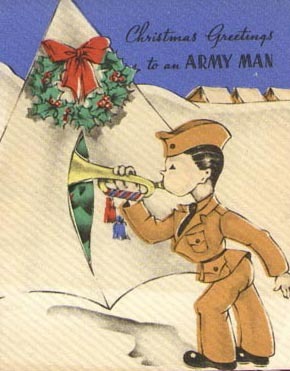
Christmas during World War II found Americans on many fronts. In 1941, only a few weeks after the Pearl Harbor attack, American soldiers were putting up a fighting retreat in the Philippines. In 1942, soldiers fought on Guadalcanal and New Guinea, and in Tunisia. In 1943, US forces fought in the Southwest Pacific and in Italy. Christmas of 1944 found the Allies reeling from the Battle of the Bulge in Europe and also engaged in northern Italy and back in the Philippines. Throughout the war, sailors were on the watch at sea and airmen faced the enemy in the sky. In addition, many servicemen and women were stationed far from home even if not on the front lines.
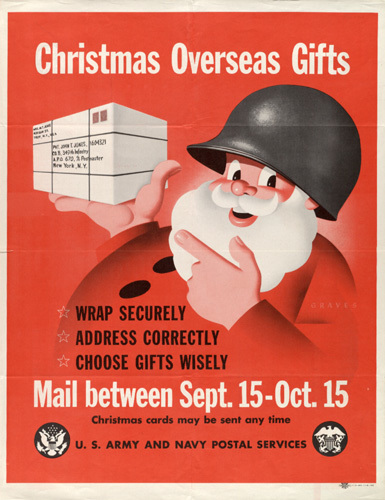
Gifts
Nothing warmed the heart more than gifts from home. The Army and Fleet Post Offices did their best to distribute presents quickly, but the sheer volume of mail and the great distances created difficulties. Families were advised to mail Christmas packages from September 15 to October 15, and the Navy restricted packages to under five pounds. Still, many servicemen, especially sailors at sea, received packages several months later. While many gifts were cherished and useful (such as candy, cookies, and warm socks), some were perplexing, such as neckties and cologne.

US Army Pfc. W.J. Kessler, Pfc. J.L. Proffitt, Pvt. B. Narter, Cpl. T.J. Barnewski, and Pfc. J. Stoll with Christmas packages from home for their artillery unit, Germany, 26 Nov 1944 (US Army Signal Corps)
Food
The armed services went out of their way to provide special holiday meals whenever possible. Those serving on ships or on fixed bases, either at home or abroad, had elaborate meals of turkey and ham with all the fixings. Even on the front lines, kitchens tried to provide turkey dinners. However, in 1942 on Guadalcanal, the troops were happy simply to receive an orange and a warm beer.

US troops eating Christmas dinner on a haystack, Italy, 25 December 1943 (US National Archives)
Decorations
Traditional decorations were scarce, but improvisation and creativity reigned. On the hospital wards overseas, nurses snipped tin from used plasma cans to make stars to string from the tent ceilings or to decorate little trees. Ration tins and foil wrappings were used for other makeshift decorations.

Troops of US 3rd Infantry Division (S/Sgt. John Suchanek, Pfc. Joseph Pierro, Sgt. Charles Myrich, Sgt. Leon Oben) open Christmas gifts from home, Pietramelara, Italy, 16 December 1943 (US Army Center of Military History)
Celebrations
Many bases arranged Santa visits, concerts, and parties for the men. In addition, Americans often put together parties for local children. For example, the airmen of the 94th Bombardment Group stationed in Bury St. Edmunds threw a big party for British orphans.

Sgt. Hiram Prouty of US 175th Infantry Regiment dressed as Santa Claus, arriving on a M3 medium tank, Perham Down, England, 5 December 1942 (US Army Signal Corps)
Most of all, the perilous times reminded the serviceman and woman of the reason for Christmas, the birth of Jesus Christ. Christmas services were held on all fronts, and the carols about “peace on earth, goodwill to men” were sung with special fervor.
Being separated from family and friends during the holidays made war that much more difficult for those in the military, but creativity and generosity made Christmas meaningful and memorable.

Pennsylvania soldiers in 10th Regiment in Camp Lee’s Quartermaster Replacement Center sing carols around the tree, Camp Lee, VA, December 1941 (US Army Center of Military History)
December 11, 2019
12 Days of Christmas Giveaway!
 Welcome to the 12 Days of Christmas Giveaway – Day 11! Every day from December 1-12, 2019, we’re picking one random winner. Today’s winner will receive ELEVEN books, including my next novel, The Land Beneath Us (will be mailed when I receive my copies in late January) – plus this darling ornament from Jennifer Deibel. Jennifer’s debut novel will be coming in early 2021 from Revell Books, and it’s delightful!
Welcome to the 12 Days of Christmas Giveaway – Day 11! Every day from December 1-12, 2019, we’re picking one random winner. Today’s winner will receive ELEVEN books, including my next novel, The Land Beneath Us (will be mailed when I receive my copies in late January) – plus this darling ornament from Jennifer Deibel. Jennifer’s debut novel will be coming in early 2021 from Revell Books, and it’s delightful!

Tomorrow, Dec. 12, the winner will receive the books, the ornament, and a $100 Amazon gift card! See which books you could win by visiting the author’s websites:
Day 1 – Tari Faris
Day 2 – Katherine Reay
Day 3 – Tina Radcliffe
Day 4 – Sarah Ladd
Day 5 – Liz Johnson
Day 6 – Jessica R. Patch
Day 7 – Kristy Cambron
Day 8 – Jill Kemerer
Day 9 – Lindsay Harrel
Day 10 – Sara Ella
Day 11 – Sarah Sundin and Jennifer Deibel
Day 12 – Liz Johnson
Enter the Rafflecopter form below by following some of your favorite authors on social media and signing up for their newsletters.
December 9, 2019
Christmas in World War II – The US Home Front
 Although World War II did not take a holiday, Americans at home and abroad did their best to celebrate Christmas. Wartime separations and deprivations made festivities poignant and bittersweet. This post looks at Christmas on the US Home Front. See also: Christmas for American servicemen and women.
Although World War II did not take a holiday, Americans at home and abroad did their best to celebrate Christmas. Wartime separations and deprivations made festivities poignant and bittersweet. This post looks at Christmas on the US Home Front. See also: Christmas for American servicemen and women.
Families on the US Home Front dealt with painful separations as sons and daughters, husbands and fathers were away from home in the service. The holiday season highlighted this pain. Those left at home wanted to make Christmas festive, especially for the children.

Gifts
Gift giving presented unique challenges during World War II. While wartime income was high in the USA, few products were available on the shelves. Many consumer items weren’t manufactured due to shortages of raw materials and conversions of factories for military use. Clothing wasn’t rationed in the United States, but restrictions did apply and people were encouraged to make do with less. By 1944, a severe paper shortage even reduced the supply of books.

Hardest of all were the scarcities of toys for the children. Toys with metal or rubber parts weren’t available. Manufacturers switched to wood and cardboard and to the new plastics that were coming out. Popular wartime toys included dolls, wooden jeeps and airplanes, and “Bild-A-Sets,” which allowed children to construct cardboard play-sets, often with military themes.
The US government provided a solution to the gift dilemma and encouraged the purchase of war bonds for Christmas presents.
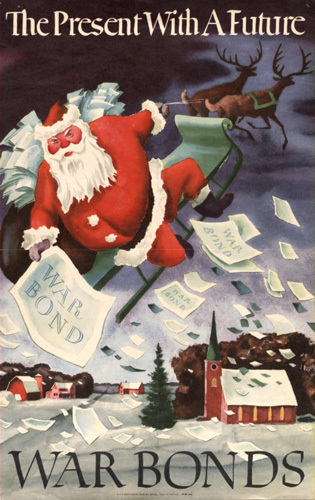
Food
Christmas dinners weren’t quite as elaborate as before the war. Rationing of sugar and butter meant fewer sweets. Meat, including ham, was rationed. Although turkey wasn’t rationed, the armed services worked hard to provide turkey dinners to the servicemen overseas, which meant fewer turkeys on the Home Front.
Travel
The holiday tradition of traveling to visit family and friends had to be curtailed during the war. Gasoline was rationed, and civilians were discouraged from train travel to free the rail system for movement of troops and supplies.
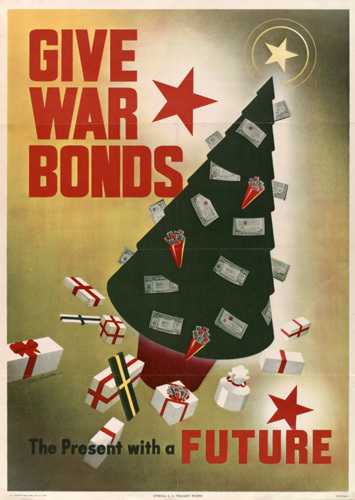
Decorations
Outdoor Christmas lights were one of the first wartime casualties. In Antioch, California, for example, outdoor Christmas lights were turned off on December 11, 1941, and the tradition of lighting the community Christmas tree was postponed for the duration. Blackout conditions on the West Coast, dim-outs on the East Coast, and later a nationwide dim-out to conserve fuel meant Christmas might be merry—but not quite as bright.
Christmas trees were harder to obtain due to labor shortages and shipping priorities, but were still available in many communities.
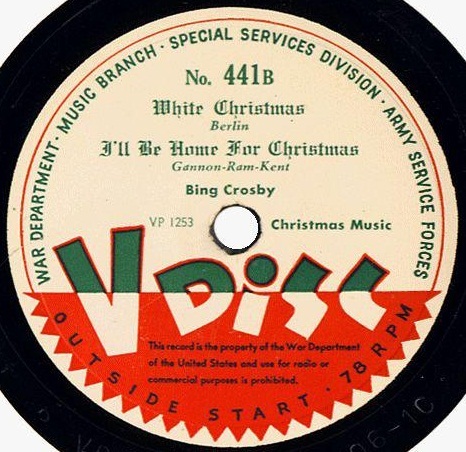
V-disc with Bing Crosby recordings of “White Christmas” and “I’ll Be Home for Christmas,” 1945 (public domain via Wikipedia)
Music
Christmas in World War II left a lasting musical legacy. Bing Crosby’s recording of “White Christmas” topped the charts in December 1942 and has since sold over 50 million copies, making it one of the biggest hits of all time. “I’ll Be Home for Christmas” was the hit for Christmas 1943, and Judy Garland’s “Have Yourself a Merry Little Christmas” was in the Top Ten in 1944. These songs share a soft melancholy, a nostalgia for home, a wistfulness for tradition, and an optimistic hope for the future that resonated in wartime and still resonates today.
Celebrating Christmas in World War II required ingenuity and flexibility, but Americans at home and abroad set aside their troubles to commemorate Christ’s birth.
December 8, 2019
Today in World War II History—December 8, 1939 & 1944

Airfield Number Two burning after American air raid, Iwo Jima, early 1945 (US Naval History and Heritage Command)
75 Years Ago—December 8, 1939: In a Gallup poll, 96.5% of Americans oppose the US entering World War II.
75 Years Ago—Dec. 8, 1944: US Navy and US Army Air Force begin 72-day pre-invasion bombardment of Iwo Jima.
December 6, 2019
Today in World War II History—December 6, 1939 & 1944

Lt. Col. James Earl Rudder, commander of US 2nd Ranger Battalion, on Pointe du Hoc in Normandy, 7 June 1944 (Texas A&M Cushing Library)
80 Years Ago—December 6, 1939: Musical Du Barry Was a Lady premieres on Broadway, featuring hit songs “Give Him the Ooh-La-La” and “Well, Did You Evah!”
75 Years Ago—Dec. 6, 1944: Col. James Earl Rudder leaves command of the legendary US 2nd Ranger Battalion, which had taken Pointe du Hoc on D-day, and takes command of the 109th Infantry Regiment.
December 5, 2019
Above the Fold, by Rachel Scott McDaniel
 In 1922, Elissa Tillman is tired of serving as a secretary at her father’s newspaper, the Pittsburgh Review, and she’s tired of only having articles published under a male pen name. Finally, she believes she has a crack at a big scoop – until she discovers her father has hired a new reporter and assigned him the story. To make things worse, the new reporter is Cole Parker, Elissa’s childhood friend and the old flame who broke her heart several years earlier.
In 1922, Elissa Tillman is tired of serving as a secretary at her father’s newspaper, the Pittsburgh Review, and she’s tired of only having articles published under a male pen name. Finally, she believes she has a crack at a big scoop – until she discovers her father has hired a new reporter and assigned him the story. To make things worse, the new reporter is Cole Parker, Elissa’s childhood friend and the old flame who broke her heart several years earlier.
Cole’s plans to make it big in New York City have died, but he holds out hope for a second chance back in Pittsburgh – and to make things up to Elissa. However, Elissa is determined to thwart both plans. When a millionaire inventor, Cole’s one-time mentor, is murdered, Mr. Tillman stakes out a competition for Cole and Elissa to write the best article about the news story. Cole and Elissa may find themselves in danger – from the murderers, from demons of the past, and from their own bruised hearts.
What a blast! In Above the Fold, the Roaring Twenties in Pittsburgh comes to life, from the sooty streets to the speakeasies to the raucous world of journalism. Both Cole and Elissa are appealing – strong and sassy, but deeply vulnerable – and their romance is swoon-worthy. Rachel Scott McDaniel‘s debut novel will keep you flipping pages to the end!



